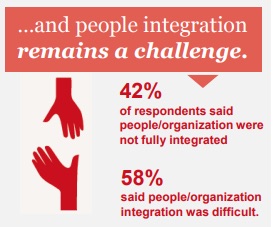Sponsored by:

Isolating the impact that Learning and Development teams (L&D) have on their organizations is the holy grail of our industry. We must shift from reactive participants to proactive organizational change leaders.
A recent Deloitte report cited record-setting activity in mergers and acquisitions (M&A) within the last seven years, amounting to $10 trillion in domestic transactions. In this report, 46% of respondents said that less than half of their transactions over the last two years generated expected value or ROI.

The disconnect between investments in M&A and financial success provides an opportunity for L&D leaders. It should come as no surprise that M&A success most often is measured in terms of financial outcomes (e.g., share price, profits). But M&A are a significant organizational change. So early success factors are best measured by the integration of people and processes.
This article will explore challenges, common mistakes, and solutions around organizational integrations.
What Goes Wrong
In order to develop an effective plan to support an M&A integration effort, measurement is paramount. There are three common benchmarks that can be used to measure success before and after an organizational integration:
1. Turnover
Though workforce reductions often are used to reduce costs during M&A, voluntary turnover can quickly lead to damaging losses. A review of 2000 organizations found an 11.8% difference in voluntary turnover between organizations that have gone through an integration and those that haven’t.
2. Brand Impact
Over the last few years, we have seen progressively more organizations try to measure the impact of their brand on the success of the organization. A poorly executed M&A can lead to a lack of consistency in brand assets, mission, vision, and values, which inevitably will hurt the customer experience. However, L&D can partner with Marketing to ensure the transition doesn’t affect brand consistency or Net Promoter Score.
3. Productivity and Operational Compliance
The majority of AllenComm clients going through M&A consider communication to be a key factor for organizational productivity. Poor communication from management can cause feelings of anxiety and insecurity, and poor communication between business units can slow down critical business processes. Over the years, we’ve seen millions of dollars lost due to miscommunication around IT and compliance during organizational integrations. Often, this comes down to a lack of specific training and failures in operational compliance between merged business units.
Critical Steps and Focus Areas for Organizational Integration
It’s not as if business leaders are unaware of the impact of workplace culture on performance. Among the internal factors that lead to unsuccessful M&A, Deloitte respondents cited cultural alignment, and talent issues. Moreover, research by PwC shows similar challenges with people integration. Some 42% of business leaders reported their people/organizations were not fully integrated and 58% expressed difficulty enabling integration.

This is where employee training and development comes into play. Your role as an L&D leader is instrumental to the success of M&A. So here are a few of the best practices that have become a part of our standard process when supporting a business transformation:
Analysis and Alignment: Creating a framework to measure the current state of organizational efficacy and desired state is the first step in an effective transition, and it will set the stage for the focus for your training. Without this benchmark data, you won’t have the information needed to proactively drive change. It’s best to start with a short needs analysis—including an audience analysis, interviews, site visits, focus groups, and surveys—to build a comprehensive view of your employees, their concerns, and expectations for M&A process.
As with any corporate training initiative, M&A typically have specific business objectives. Using a performance-mapping process that connects motivation, knowledge, and behaviors to organizational competencies provides L&D measurable objectives to design a learning solution and set benchmarks to evaluate the impact. For AllenComm clients, the mapping process provides the first indication of the scope and scale needed to drive M&A business objectives.
Shaping Behaviors with Phased Integration: Reconciling differences in business processes usually means shaping the behaviors of employees from one organization to match the other. Though this kind of change won’t occur without bottom-up buy-in from your employees, there are a few key methods to make the transition easier:
- Clearly communicate why this change is necessary
- Detail the benefits to individual employees and the organization
- Implement training and socialization of new behaviors with a phased approach
Phasing your organizational changes will go a long way to keep employees from feeling overwhelmed. For example, Value-Expectancy theories of motivation suggest keeping the immediate demand proportionate to the motivating factors. Essentially, don’t let any individual step seem too difficult for the learners to accomplish. Otherwise, learners will lose motivation and revert to the processes they already know.
Organizational Integration: Medical Software Client
One of our clients, a large health-care provider, faced a similar M&A challenge in blending multiple cultures. After a merger, the company was tasked with developing a single code of conduct and getting both groups to embrace a new culture and identity. This compliance training initiative served as a strategic catalyst for a larger organizational transformation, but the goal was to shift behaviors, critical thinking, and resource consumption to drive new company objectives. By emphasizing company values and providing practical tools to improve employee performance, their compliance training program was able to align behaviors along a singular path to success. The solution increased employee engagement during a transition most often associated with high turnover. Coincidentally, in the span of time since the merger and the following organizational integration training initiative, share prices have increased.
Conclusion
Though financial measurements are important, they aren’t the most effective lens for evaluating early success of business transformation. Organizational integrations depend on aligning cultures and processes. So it’s vital for Learning and Development leaders to offer a phased approach that can measure success as a product of human factors.
Ron Zamir, CEO of AllenComm, has led learning and business organizations in Israel, South Africa, and across the U.S. He brings 22 years of experience in marketing, sales, and education methodologies to the field of corporate training, and has used his experience to drive the cutting edge of corporate training. Zamir is also an Honors graduate of Hebrew University, and holds degrees and certifications in fields such as International Relations, Business, Archaeology, and Instructional Design. Outside of the office, he devotes his time to local charter school boards and economic development initiatives.

